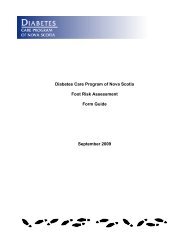CDE Appendix 1 Literature Review - Central East Local Health ...
CDE Appendix 1 Literature Review - Central East Local Health ...
CDE Appendix 1 Literature Review - Central East Local Health ...
You also want an ePaper? Increase the reach of your titles
YUMPU automatically turns print PDFs into web optimized ePapers that Google loves.
The Culture, Diversity and Equity Project: <strong>Literature</strong> <strong>Review</strong><br />
of health upstream from the healthcare sector (Gardner, 2008a; Raphael & Bryant, 2006; Exworthy & Washington,<br />
2006; Lettner, 2008a; Jain, 2007; Rachlis, 2008).<br />
By focusing analyses and solutions exclusively on healthcare service inequities, critics argue, healthcare equity<br />
frameworks limit themselves to improving the treatment of individual illness in healthcare service contexts<br />
(precluding more preventative, population-level interventions as afforded, for instance, by a population-health<br />
perspective) (Raphael & Bryant, 2006).<br />
As Mackenbach et al. argue, such ‘downstream’ healthcare focused solutions and interventions “can never totally<br />
eliminate the problem, because people will have to fall ill before [better] healthcare can repair the damage”<br />
(2002b).<br />
Research consistently shows, moreover, the relatively minor role played by health care in explaining health<br />
disparities. Exworthy et al. (2006) for instance cites research attributing to healthcare inequities “perhaps only 10<br />
percent to 15 percent of the variation in health outcomes among different groups” (see also Adler et al., 1993;<br />
McGinnis, Williams-Russo, and Knickman, 2002). Policy intervention frameworks focusing exclusively on<br />
healthcare inequities, in this light, provide limited potential for fundamentally reducing inequities in health status.<br />
Cultural competence frameworks, more specifically, have often been critiqued for their:<br />
• Neglect of broader structural, socio-economic determinants of health and inattention to inequities of power<br />
more generally, as these impact upon health and heath care (Raphael & Bryant 2006; Kumas et al., 2007;<br />
Sakamoto 2007);<br />
• Neglect of supra-individual, systemic levels of analyses (Sakamoto 2007);<br />
• Perpetuation of cultural stereotypes and cultural essentialism, in part due to a reliance on static and<br />
homogenising concepts of culture that fail to adequately account for cultural hybridity (‘cross culture’), fluidity,<br />
and intersectionality (Engerbretson et al., 2008; Turner, 2008; Carpenter-Song et al., 2007; Kumas et al., 2007;<br />
Wong et al., 2003);<br />
• Faulty epistemological premises depicting culture as a stable object of knowledge that can be known and<br />
‘mastered’ (which, critics suggest, can result in a lack of ‘cultural humility’ towards ‘others’) (Wong et al.,<br />
2003; Tervalon and Garcia, 1998)<br />
• Narrow focus on racial and ethnic dimensions of ‘culture’ and failure to account for and conceptualize other<br />
intersecting cultural identities, patterns and experiences (SHAD, 2008; Raphael & Bryant, 2006)<br />
• Lack of evidence-base substantiating the positive impact of cultural competence interventions on the ground<br />
(Beach et al., 2006; Anderson et al., 2003; Whitley, 2007); and<br />
• Abstract postulations which lack operational specificity or translatability (Sue, 2006).<br />
Counterexamples, nevertheless, can be found for each of these critiques demonstrating the continuing evolution and<br />
maturation of the cultural competence literature.<br />
2.5 RECOMMENDED FEATURES OF A HEALTH EQUITY FRAMEWORK<br />
Key features of a health equity framework recommended based on this review of the literature are listed below:<br />
• Combines an evidence-based conceptual model of the causes/determinants of health and health in/equity with a<br />
practical intervention framework (e.g. New Zealand’s Framework for Reducing Inequalities in <strong>Health</strong> and the<br />
WHO’s Closing the Gap Framework). Conceptual models most useful to policy-making balance conflicting<br />
priorities: they help to illuminate the multiple relevant causal pathways for health in/equity and entry points for<br />
intervention, on the one hand (i.e. integrated models), yet, are not too complex for policy-makers and the wider<br />
public to understand, on the other hand (Mackenbach, 2002a);<br />
52

















